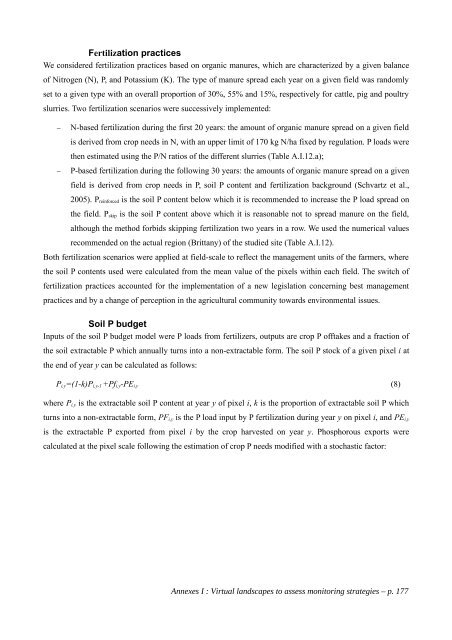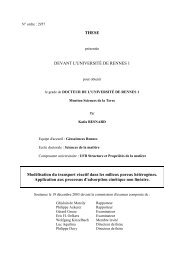Paysages virtuels et analyse de scénarios pour évaluer les impacts ...
Paysages virtuels et analyse de scénarios pour évaluer les impacts ...
Paysages virtuels et analyse de scénarios pour évaluer les impacts ...
Create successful ePaper yourself
Turn your PDF publications into a flip-book with our unique Google optimized e-Paper software.
Fertilization practices<br />
We consi<strong>de</strong>red fertilization practices based on organic manures, which are characterized by a given balance<br />
of Nitrogen (N), P, and Potassium (K). The type of manure spread each year on a given field was randomly<br />
s<strong>et</strong> to a given type with an overall proportion of 30%, 55% and 15%, respectively for cattle, pig and poultry<br />
slurries. Two fertilization scenarios were successively implemented:<br />
− N-based fertilization during the first 20 years: the amount of organic manure spread on a given field<br />
is <strong>de</strong>rived from crop needs in N, with an upper limit of 170 kg N/ha fixed by regulation. P loads were<br />
then estimated using the P/N ratios of the different slurries (Table A.I.12.a);<br />
− P-based fertilization during the following 30 years: the amounts of organic manure spread on a given<br />
field is <strong>de</strong>rived from crop needs in P, soil P content and fertilization background (Schvartz <strong>et</strong> al.,<br />
2005). Preinforced is the soil P content below which it is recommen<strong>de</strong>d to increase the P load spread on<br />
the field. Pskip is the soil P content above which it is reasonable not to spread manure on the field,<br />
although the m<strong>et</strong>hod forbids skipping fertilization two years in a row. We used the numerical values<br />
recommen<strong>de</strong>d on the actual region (Brittany) of the studied site (Table A.I.12).<br />
Both fertilization scenarios were applied at field-scale to reflect the management units of the farmers, where<br />
the soil P contents used were calculated from the mean value of the pixels within each field. The switch of<br />
fertilization practices accounted for the implementation of a new legislation concerning best management<br />
practices and by a change of perception in the agricultural community towards environmental issues.<br />
Soil P budg<strong>et</strong><br />
Inputs of the soil P budg<strong>et</strong> mo<strong>de</strong>l were P loads from fertilizers, outputs are crop P offtakes and a fraction of<br />
the soil extractable P which annually turns into a non-extractable form. The soil P stock of a given pixel i at<br />
the end of year y can be calculated as follows:<br />
Pi,y=(1-k)Pi,y-1 +Pfi,y-PEi,y<br />
where Pi,y is the extractable soil P content at year y of pixel i, k is the proportion of extractable soil P which<br />
turns into a non-extractable form, PFi,y is the P load input by P fertilization during year y on pixel i, and PEi,y<br />
is the extractable P exported from pixel i by the crop harvested on year y. Phosphorous exports were<br />
calculated at the pixel scale following the estimation of crop P needs modified with a stochastic factor:<br />
Annexes I : Virtual landscapes to assess monitoring strategies – p. 177<br />
(8)



